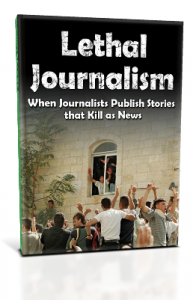
Lethal Journalism Worldwide
Lethal narratives have probably been around since the beginnings of warfare. They are designed to accuse the enemy of the most heinous crimes in order to justify the most violent responses. Lethal narratives attribute malevolent intention to the executor of these evil deeds – child killing, civilian massacring, deliberate killing sprees. They are weapons of war designed to demonize an enemy one wants to exterminate (and often an enemy one systematically projects).
Lethal Journalists, for a variety of reasons, inject lethal narratives into the public sphere as “news,” as what, they, in their considered judgment, think “actually happened.” Earlier war-mongering journalists may have served their governments if not their people; but more rarely have journalists served the enemies of the very civil society they are charged with informing. And since that same society, in turn, depends heavily on the accuracy of their reporting in order to make sound judgments at the voting booth and in opinion polls, such failures have serious consequences.
When the Boston Globe published fake pictures of rapes at Abu Graibh, they at once fell dupe to a completely contrived lethal narrative, and intensified the outrage and desire for revenge in the Arab world. Similarly when Newsweek published their false report of desecrating Qur’ans at Gitmo, they did the same, in this case, triggering riots in which at least 15 people were killed. The cousin of one of the London Bombers (7-7-2005) claimed that incidents like the Qur’an desecration [sic] have always been on his mind.”
In the Arab-Israeli conflict, this problem takes on a specific importance because so much of the Arab depiction of the Jews, as we see elsewhere in their public culture, partakes of the worst excesses of European anti-semitism, including the Holocaust. This problem is still more intensely virulent in the Palestinian public sphere. In the face of accusations of murderous intention, of massacre, of wanton violence, one would expect journalists to demand strong proofs before declaring this “news.” CNN’s Mike Hanna looked at Talal Abu Rahma’s footage and passed on the option of telling his lethal narrative.
Given the importance and distortion involved in Palestinian lethal narratives – a candidate for the definition of hate-speech if there ever were one – one might expect journalists from progressive cultures that openly promote peaceful relations between neighbors to have some knowledge of the Palestinian propensity for scapegoating and hate-mongering. Journalists who claim to live on Baker street (Sherlock’s address) should in principle, be able to identify these lethal narratives and present them to us (their readers and viewers) as the weapons of war that they are.
Journalists covering such an asymmetric conflict would presumably have developed an ability to peel the accompanying lethal narrative off the evidence available to them. One might even hope that they could distinguish between those narratives made up out of whole cloth (al Durah), with those which take advantage of real loss of life to make unfounded accusations (Gaza Beach). But instead, and perhaps in part because attacking Israel is not the same as attacking one’s own society, Western journalists are much more likely, indeed eager, to publish false accusations as news.
